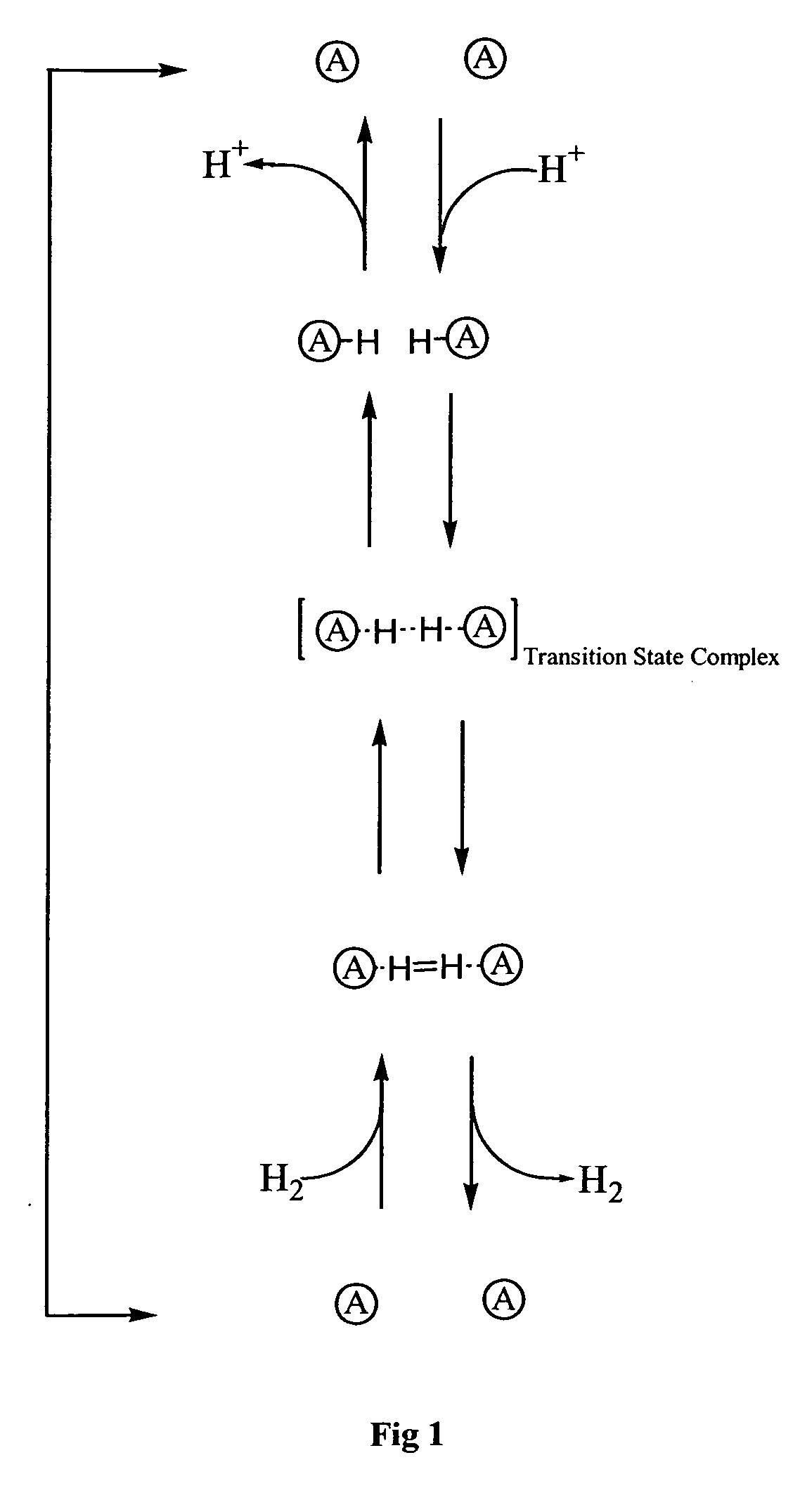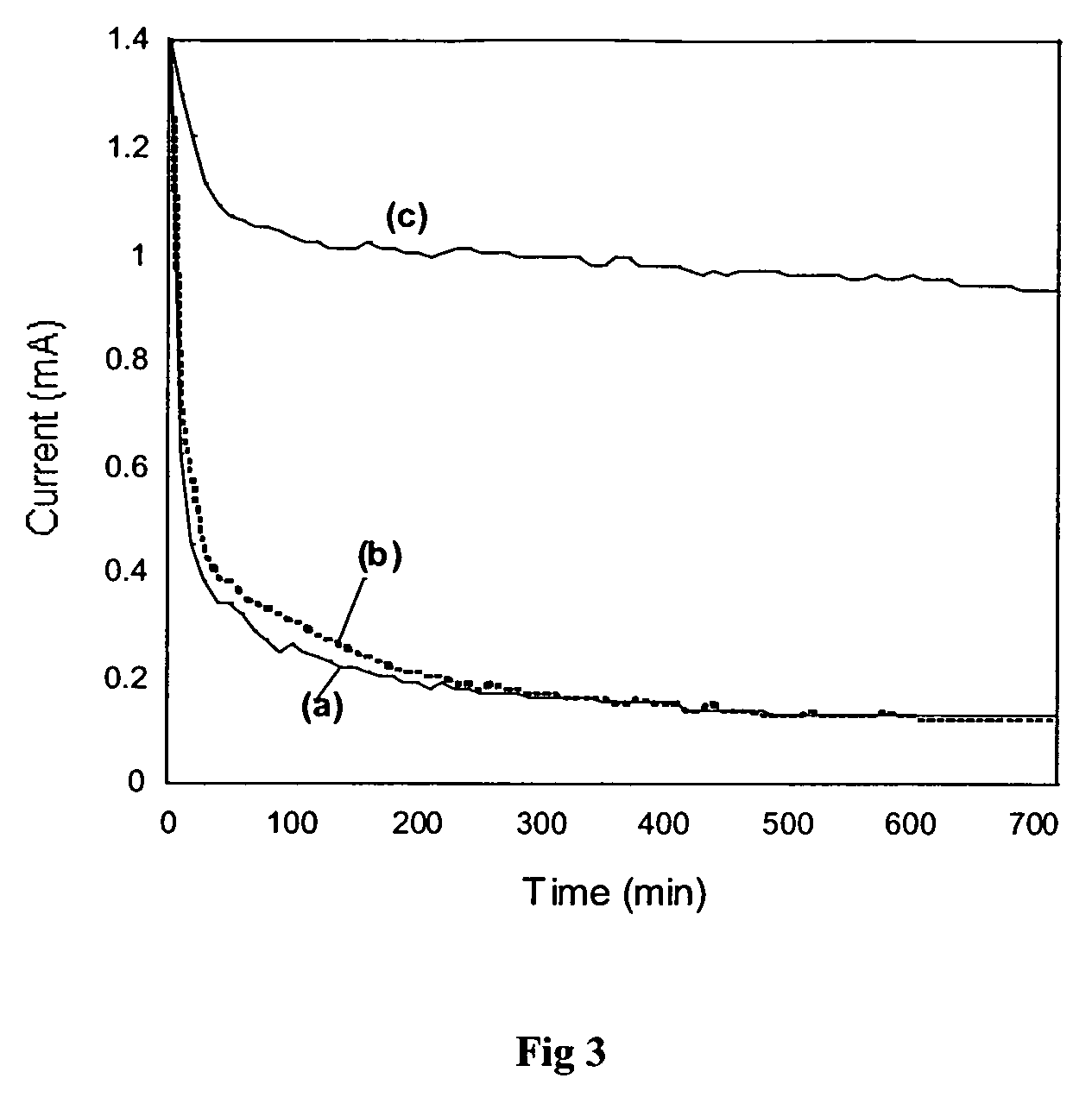Novel catalysts and processes for their preparation
- Summary
- Abstract
- Description
- Claims
- Application Information
AI Technical Summary
Benefits of technology
Problems solved by technology
Method used
Image
Examples
example 1
[0132] A. Methods to Prepare Polypyrrole-Ferrocene Monosulfonate (PPy-FcSO3), a Statistical Proximity Catalyst for the Conversion of H+ to H2:
[0133] Polypyrrole-ferrocene monosulfonate (PPy-FcSO3) (formula IV) could be electrodeposited by potentiodynamic growth performed at 100 mV s−1 between −0.8 V and +0.8 V (vs. Ag / AgCl) on a platinum disk electrode immersed in an aqueous coating solution containing pyrrole (0.5 M) and ammonium ferrocene sulphonate (0.02 M). The cyclic voltamogram of growth displayed the expected increase in current with increasing cycles.
[0134] Two sets of redox peaks were identified as the polypyrrole and ferrocene redox potentials. From the growth cyclic voltammogram a potential of +0.56 V was selected as ideal for potentiostatic growth.
[0135] PPy-FcSO3 could be electrodeposited by potentiostatic growth at +0.56 V on a platinum disk electrode immersed in the same coating solution. The chronoamperogram displayed an increasing current over time, after the in...
example 2
Comparative Studies Using Known Proximity (Non-Statistical)-Based Catalysts
[0163] Another test of whether a catalyst is activated by a statistical proximity effect is to compare its catalytic properties with those of closely related materials which are known to catalyse a reaction because of the influence of proximity. The proximity in the latter arises from deliberate molecular engineering and not statistical influences; i.e. the catalytic groups have been chemically tethered to each other.
[0164] For example, as mentioned earlier, the species [1.1]ferrocenophane is known to be an active catalyst in the conversion of H+ to H2. It catalyses the reaction because the two ferrocene catalytic groups within [1.1]ferrocenophane have been synthesised so as to be the correct distance apart and in the correct disposition to stabilise the transition state of the reaction.
[0165] The co-polymer poly(pyrrole-co-(3-(1-[1.1]ferrocenophane-4-butyl)pyrrole)) (PPy-co-1) (formula (VI)), which cont...
example 3
Comparative Studies Using Closely Related Catalysts which are Likely to be Proximity-Based.
[0171] A further test of whether a catalyst is activated by a statistical proximity effect is to compare its catalytic properties with those of closely related materials which are likely to catalyse a reaction because of the influence of proximity. The proximity effects in these materials arise from deliberate molecular engineering and not statistical influences; i.e. the catalytic groups have been chemically tethered to each other.
[0172] The co-polymer polypyrrole-co-3-(4-ferrocenylbutyl)pyrrole (PPy-co-2) (formula (VIII) which contains tethered ferrocene groups, could be electrodeposited on a platinum disk electrode of 0.0177 cm2 area by potentiodynamic, potentiostatic, or galvanostatic growth from a dichloromethane solution containing pyrrole (0.01 M), monomer 2 (formula (IX)) (0.01 M), and tetrabutylammonium perchlorate (0.1 M).
[0173] Potentiodynamic growth was performed at 100 mV s−...
PUM
| Property | Measurement | Unit |
|---|---|---|
| Temperature | aaaaa | aaaaa |
| Polarity | aaaaa | aaaaa |
| Concentration | aaaaa | aaaaa |
Abstract
Description
Claims
Application Information
 Login to View More
Login to View More - R&D
- Intellectual Property
- Life Sciences
- Materials
- Tech Scout
- Unparalleled Data Quality
- Higher Quality Content
- 60% Fewer Hallucinations
Browse by: Latest US Patents, China's latest patents, Technical Efficacy Thesaurus, Application Domain, Technology Topic, Popular Technical Reports.
© 2025 PatSnap. All rights reserved.Legal|Privacy policy|Modern Slavery Act Transparency Statement|Sitemap|About US| Contact US: help@patsnap.com



